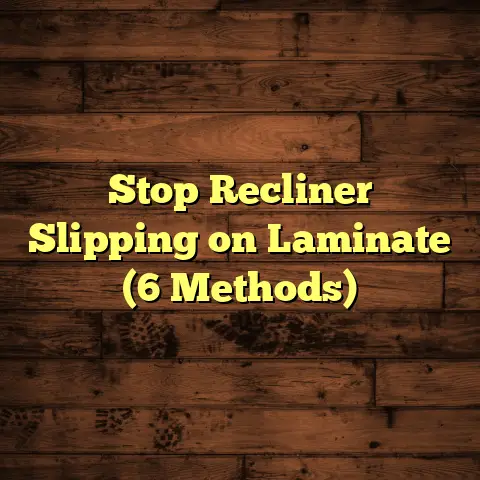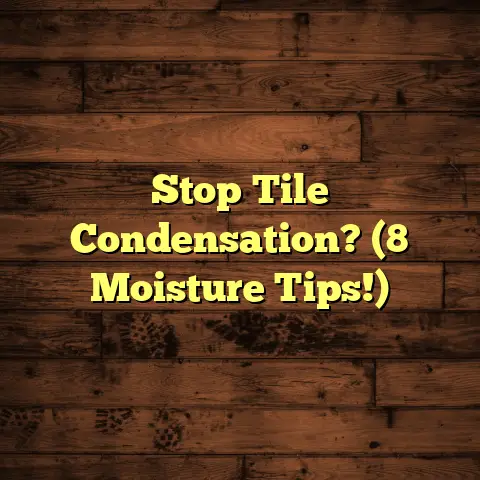Eliminate Squeaking Floors? (2 Min Fix!)
You’re not alone! It’s a super common problem, and guess what? It’s often a super easy fix.
I’m going to walk you through some quick solutions, but first, let’s talk about why floors squeak in the first place, especially since where you live plays a big part.
Introduction: The Squeak Symphony
Let’s face it: squeaking floors can be a real pain. They’re like tiny, annoying roommates that never pay rent and constantly complain.
But before you reach for the sledgehammer, let’s understand why this happens.
Think of your floor as a complex instrument. Different climates, like different conductors, can affect its tune.
Wood, in particular, is a diva. It loves to react to changes in humidity and temperature, expanding and contracting like it’s doing yoga.
This movement is often the culprit behind those unwanted squeaks.
Identify Climate-Specific Needs
-
Cold Climates:
Imagine living in a place where the temperatures drop below freezing for months.
The extreme cold causes wood to contract, creating gaps between floorboards.
These gaps then rub against each other or the subfloor when you walk, resulting in a squeak.
Think of places like Minnesota, Canada, or even the colder parts of Europe.
These regions often see homes with squeaky floors during the winter months. * Humid Climates:
Now picture a place where the air is thick with moisture, like Florida or the Gulf Coast.
High humidity causes wood to expand. If the wood expands too much, it can buckle and creak as the boards shift against each other.
It’s like trying to fit a puzzle piece that’s slightly too big.
You’ll hear the strain as it tries to squeeze in. * Seasonal Changes:
Even if you don’t live in an extreme climate, the changing seasons can wreak havoc on your floors.
In the spring, as the humidity rises, your floors might start creaking.
Then, in the fall, as the air dries out, the squeaks might disappear, only to return with a vengeance the following winter.
It’s a never-ending cycle! * Recommendations for Humidity Control:
The good news is that you can fight back against the elements.
Using dehumidifiers in humid climates and humidifiers in dry climates can help maintain optimal indoor humidity levels.
According to the EPA, maintaining a relative humidity between 30-50% can help prevent problems like mold growth and wood damage.
This not only helps your floors but also improves your overall indoor air quality.
Section 1: Understanding Squeaky Floors
Okay, so we know climate plays a role. But let’s dig deeper into the mechanics of a squeaky floor.
What Causes Squeaky Floors?
It’s all about friction, baby!
When you walk across a floor, the floorboards move slightly.
If they’re rubbing against each other, the subfloor, or even loose nails or screws, you’re going to hear that telltale squeak.
Think of it like this:
-
Friction: Wood rubbing against wood, metal, or even concrete.
-
Loose Fasteners: Nails or screws that have worked their way loose over time, allowing the floorboards to move more than they should.
-
Settling Structures: As houses settle, the subfloor can shift, causing the floorboards to become uneven and prone to squeaking.
Types of Flooring Prone to Squeaking
Not all floors are created equal. Some are just more prone to squeaking than others.
-
Hardwood:
Ah, the classic! Hardwood floors are beautiful, but they’re also the most susceptible to squeaking.
Why? Because they’re solid wood, they expand and contract more than other types of flooring.
This movement can lead to those annoying squeaks. * Laminate:
Laminate floors are more stable than hardwood, but they can still squeak if they’re not installed correctly or if the subfloor is uneven.
The squeaking in laminate floors often comes from the underlayment rubbing against the subfloor. * Engineered Wood Flooring:
Engineered wood is more stable than solid hardwood because it’s made up of multiple layers of wood glued together.
This construction makes it less prone to expanding and contracting, which means fewer squeaks.
However, it can still squeak if it’s not installed properly.
Section 2: Quick Fix Solutions
Alright, let’s get down to business! You’re probably thinking, “Enough with the explanations, just tell me how to fix the squeak!”
I hear you. Here’s a 2-minute fix that might just save your sanity.
The 2-Minute Fix: Step-by-Step Guide
-
Identify the Source of the Squeak:
This is the most important step. You need to pinpoint exactly where the squeak is coming from.
Walk around the room and listen carefully.
You might even want to have someone else walk while you listen.
Once you’ve found the squeaky spot, mark it with some tape. 2. Gather Required Tools:
For this quick fix, you’ll need:
- A screwdriver (preferably a drill with a screwdriver bit)
- Wood screws (1 1/4 inch should do the trick)
- Talcum powder or graphite lubricant (optional)
-
Apply the Fix:
-
Tighten Loose Floorboards:
If the squeak is coming from a loose floorboard, simply drive a screw through the floorboard and into the joist below.
Make sure you’re hitting the joist! You can usually find the joists by looking for nail patterns in the floor.
If you’re not sure where the joists are, you can use a stud finder.
Drive the screw in at an angle for a better grip. * Lubricate Gaps:
If the squeak is coming from friction between floorboards, sprinkle some talcum powder or graphite lubricant into the gaps.
This will help reduce the friction and eliminate the squeak.
You can use a small brush to work the powder or lubricant into the gaps.
Alternative Quick Fixes:
Okay, so the 2-minute fix didn’t work? Don’t worry, I’ve got a few more tricks up my sleeve.
-
Carpet Padding as a Buffer:
If you have a rug in the area, try adding some carpet padding underneath it.
The extra padding can help absorb some of the movement and reduce the squeaking. * Floor Squeak Repair Kit:
These kits are available at most hardware stores and contain everything you need to fix squeaky floors.
They usually include special screws that are designed to grip the subfloor tightly. * Caulk to Fill Gaps:
If the squeak is coming from gaps in the baseboards or moldings, try filling the gaps with caulk.
This will help stabilize the floor and reduce the movement that’s causing the squeak.
Section 3: Long-Term Solutions to Prevent Squeaking
So, you’ve fixed the squeak. Awesome! But what about preventing it from coming back?
Here are some long-term solutions to keep your floors squeak-free.
Regular Maintenance Tips:
-
Inspect Regularly:
Take some time every few months to inspect your floors for any signs of damage or loose floorboards.
The sooner you catch a problem, the easier it will be to fix. * Maintain Proper Indoor Climate Conditions:
As we discussed earlier, humidity plays a big role in squeaky floors.
Use dehumidifiers or humidifiers to maintain optimal indoor humidity levels.
According to the American Society of Heating, Refrigerating and Air-Conditioning Engineers (ASHRAE), the ideal indoor humidity level is between 40-60%. * Proper Cleaning:
Avoid using excessive water when cleaning your floors.
Water can seep into the gaps between floorboards and cause them to swell, which can lead to squeaking.
Instead, use a damp mop or a microfiber cloth.
Flooring Materials to Consider for New Installations:
If you’re planning on installing new floors, consider these options that are less prone to squeaking:
-
Engineered Hardwood:
As mentioned earlier, engineered hardwood is more stable than solid hardwood, making it less prone to expanding and contracting.
It’s also a great option for high-moisture areas like bathrooms and kitchens. * Laminate Designed for High-Moisture Areas:
Some laminate floors are specifically designed to resist moisture.
These floors are a great option for bathrooms, kitchens, and basements. * Luxury Vinyl Plank (LVP):
LVP is a durable and waterproof flooring option that’s becoming increasingly popular.
It’s also very stable, which means it’s less prone to squeaking.
Conclusion: Silence is Golden
Squeaking floors can be a real annoyance, but they’re often easily fixable with a little bit of effort.
By understanding the causes of squeaky floors and taking proactive steps to maintain your flooring, you can keep your home squeak-free for years to come.
Remember, addressing climate-specific needs is key to preventing squeaks.
Whether you live in a cold, dry climate or a hot, humid one, taking steps to control the humidity in your home can make a big difference.
So, grab your screwdriver, some talcum powder, and get ready to silence those squeaks!
Call to Action:
I’d love to hear about your experiences with squeaky floors!
What fixes have you tried? What worked and what didn’t?
Share your stories in the comments below! Let’s create a community where we can all learn from each other and help each other solve our flooring woes.





